Square and triangle
Can you find the area of the yellow square?
Problem
Image
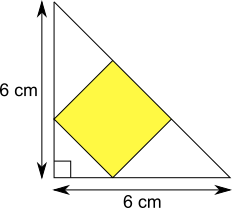
Find the area of the yellow square in this diagram.
This problem is taken from the World Mathematics Championships
Student Solutions
Image
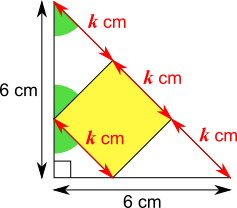
The sides of the large right-angled triangle are both 6 cm, so its angles are 90$^\circ$, 45$^\circ$, and 45$^\circ$.
The angles in the square are all right angles, so the smaller triangles around the square are also right-angled isosceles triangles.
This means that the angles shaded green on the diagram are all 45$^\circ$, and the lengths labelled $k$ cm are all equal to the side length of the square.
This is important for all of the three methods shown below:
Using congruent triangles
Image
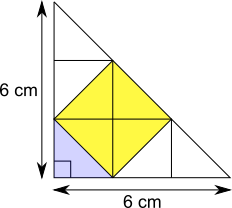
There are 9 of these triangles altogether, and 4 of them fit into the square, so the area of the square is $\frac49$ of the area of the whole triangle.
The area of the whole triangle is $\frac12\times6\times6 = 18$ cm$^2$. So the area of the square is $\frac49$ of $18$ cm$^2$, which is $8$ cm$^2$.
Using scale factors
The diagonal side of the whole triangle is equal to 3$k$ cm, and the diagonal side of the small triangle in its corner (to the bottom left of the square) is $k$ cm. So the scale factor from the small triangle to the whole triangle is 3.
Image
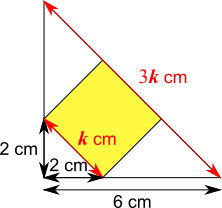
This means that the sides of the small triangle are 2 cm, since 2 cm $\times$ 3 = 6 cm.
So the area of the small triangle is 2$\times$2$\div$2 = 2 cm$^2$.
The area of the whole triangle is 6$\times$6$\div$2 = 18 cm$^2$.
So the area of the square and the two triangles on either side of it is 18 $-$ 2 = 16 cm$^2$. Each of these two triangles is congruent to half of the square, so the square occupies half of this area. So the area of the square is 8 cm$^2$.
Using Pythagoras' Theorem on the whole triangle
Image
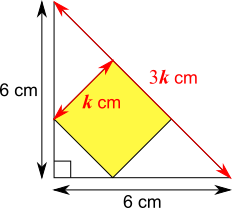
The hypotenuse of the triangle is equal to $3k$, and can also be found using Pythagoras' Theorem: $$6^2+6^2=(3k)^2\\\Rightarrow 72=9k^2\\
\Rightarrow 8=k^2$$ But $k^2$ is the area of the square. So the area of the square is $8$ cm$^2$.
